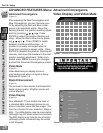
51
51
Part III: Setup
A/V Setting Descriptions: Video
Video Settings
IRIS™ is the Intelligent Room Illumi-
nation (light) Sensor. When IRIS™ is
on, your TV will automatically adjust pic-
ture contrast and brightness for best
quality (Contrast and Brightness cannot
be adjusted manually).
Contrast provides a slider to adjust
the white-to-black level. Low contrast
shows a variety of shades in darker
images, while high contrast shows
darker images more uniformly black and
makes colors appear more vibrant.
Brightness provides a slider to adjust
the overall brightness of the picture.
Sharpness provides a slider to adjust
the detail and clarity.
Color provides a slider to adjust the
color intensity.
Tint provides a slider to adjust the pro-
portion of red to green.
Color Temp (Color Temperature) allows
you to adjust how white images are dis-
played. Your choices are:
• Low 6500K or Low (for DTV): White images
will have a warm cast to them. This adjust-
ment is an average and can vary due to
ambient room lighting, video scene bright-
ness and the TV’s age. The Low 6500K
represents the 6500K industry standard for
NTSC (non-DTV) pictures.
• Medium: White images will be balanced
between the Low (warm) and High (cool)
settings.
• High: White images will have a cool cast
to them. This setting may provide the most
realistic picture under bright lighting.
Video Noise reduces minor noise (grain-
iness) in the broadcast or input signal.
Image Type maximizes the original
camera media; Video or Film. Video
media uses a video camera and is cre-
ated at 30 frames per second. Film
media uses a lm camera and is cre-
ated at 24 frames per second. Exam-
ples of Video media are live TV
broadcast such as news, special events,
or video taped programs. Examples of
lm media are motion pictures, made-
for-TV movies, and many prime time pro-
grams. Filmed media is converted by
the broadcaster or home video company
to 30 frames per second to match TV or
video standards. This conversion can
leave subtle “picture artifacts” or conver-
sion errors. Setting the Image Type to
Film can reduce the picture artifacts and
improve the picture quality.
A/V Setting Descriptions: Video


















